Banner image: 25 Chinamen having a meal break at the back of the Burketown Court House in 1894. They were illegal immigrants, arrested for crossing the South Australia--Queensland border. They had lost their jobs in the northern territory and were looking for work in Queensland.
The bureaucratic machinery of White Australia: Queensland
After much debate, the Immigration Restriction Act was passed in December 1901. It was implemented in 1902 by the former colonial Customs combined into a federal service, with restrictions on all coloureds, not just Chinese.
Initially overzealous in attempting to root out fraudulent use, the new Queensland branch of His Majesty's Customs rejected the entry of some returning Chinese expecting to re-settle in a now federated Australia. Their old colonial Queensland permits, issued under the 1888 Chinese Immigration Restriction Act, were impounded and they were forced to return to Canton.
Customs at Cooktown, the first main land port of call for vessels returning to Australia, sent Sub-Collector Ogilvy to examine incoming passengers. There was no interpreter present. After the passenger ship from Hong Kong steamed into Cooktown harbour on 14 June 1902, in the first operation of federal controls at the port, he confiscated three colonial permits and stopped these Chinamen from entering:
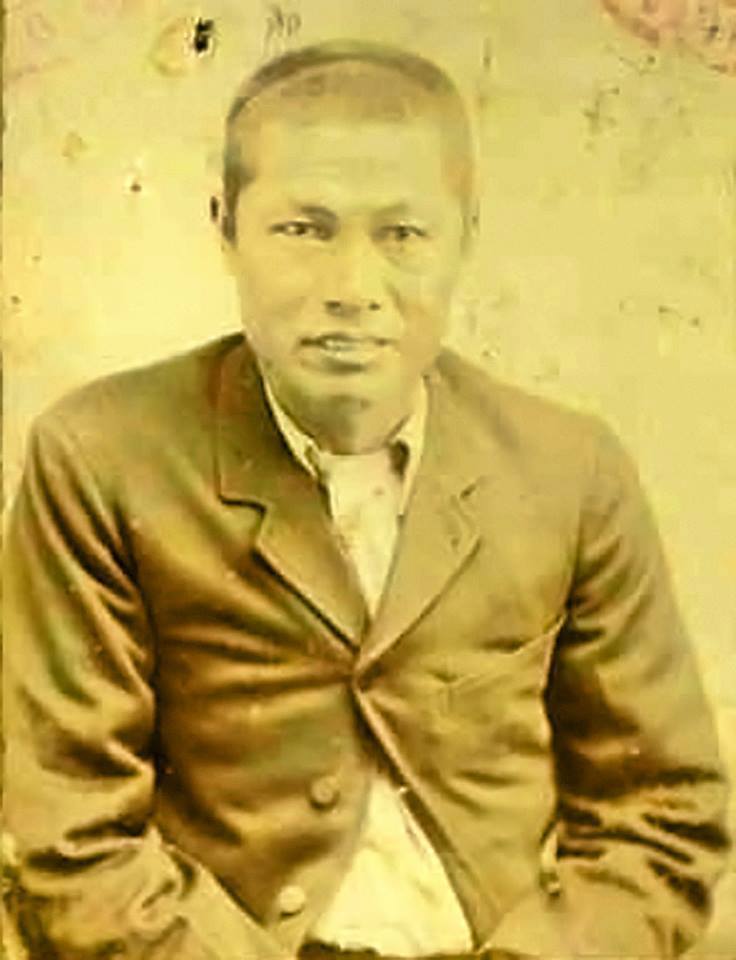 Yee Chee, a 28 years old Cantonese from Cooktown, worked as a market gardener for 5 years in the Colony before returning to Canton for a two year spell:
Yee Chee, a 28 years old Cantonese from Cooktown, worked as a market gardener for 5 years in the Colony before returning to Canton for a two year spell:
"In my opinion the person presenting this permit is not the person to whom it was granted. He does not correspond with particulars endorsed thereon. He is therefore refused permission to land and his permit is impounded and sealed to the transire. Being unable to speak English, test not put to him."

43 year old Pong Kew had run a store before he left for China early in 1901. He spoke good English. It didn't help:
"In my opinion the person presenting this permit is not the person to whom same was granted. (1) He does not resemble the photograph attached and (2) he does not correspond with the particulars endorsed therein. He is therefore refused permission to land and his permit is impounded."
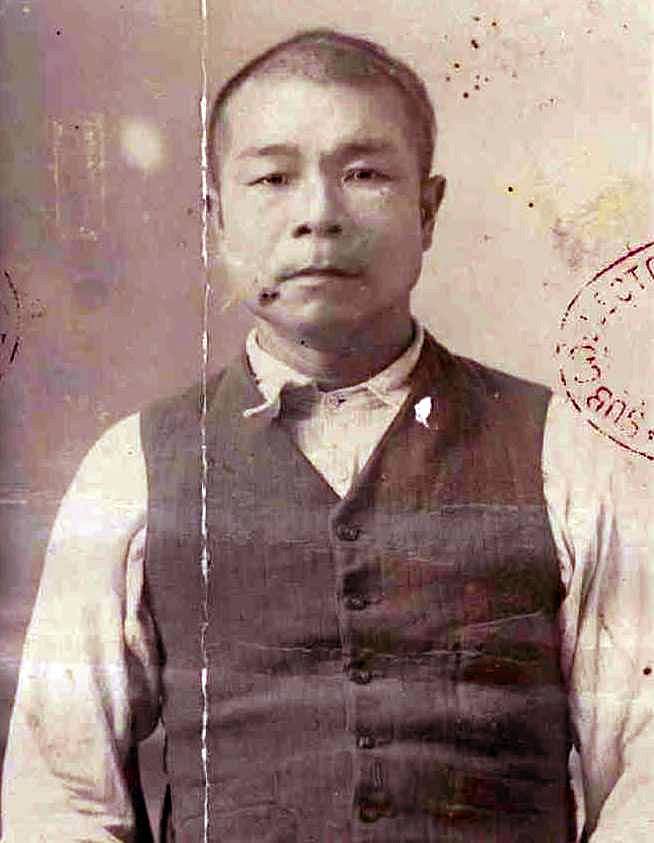
Yin Hing, 36, gardener
"In my opinion the person presenting this permit is not the person to whom same was granted. (1) He does not resemble the photograph attached and (2) he does not correspond with the particulars endorsed therein. He is therefore refused permission to land and his permit is impounded and sealed to the transire. Being unable to speak English, test not put to him.

Ogilvy scrupulously scrutinised returning Chinese for ring-ins and he didn't have to wait long -- ten days later the next steamer arrived carrying 32 year old horticulturist Chung Bow, who had arrived in the Colony as a 16 year old youth. His permit was impounded, he was forced to return to Canton.
By now Ogilvy's memos to Customs Head Office Brisbane had become a litany of rejection for permit holders: within a year he could boast of the following trophies to his superiors:
Further south, in Brisbane, similar problems with the centralisation of the administration of immigration restriction arose:
Jim Yin, a prominent Brisbane indent merchant and member of the Chinese elite, was renowned as an intermediary between officials and his countrymen. Since 1888 when Queensland, like the other Colonies, introduced tougher controls on the influx of Chinese, his interceeding had increased. What started out as a sideline to his business, obligingly helping by explaining the new requirements to his fellow clansmen, completing forms in English and the like, had become an increasingly involving but personally rewarding task.
A number of his countrymen were enjoying visiting their families in the home counties, after years of hard work in the Tropics. They were looking forward to the prospect of returning to their rewarding work in the New Gold Mountain. When the new federal laws applied, the permits issued by the Queensland state were no longer strictly valid but were expected to be honoured by the new Commonwealth. Difficulties arose in dealing with a new bureaucracy, located temporarily and far away in Melbourne:
irate letters and expensive cables are preserved on file from Chinese who were proclaimed free to return under the Chinese Immigration Restriction Act, Queensland just prior to the passing of the Federal Act. Although they qualified for re-entry under the State Act, they were now only eligible to sit (and fail) the Federal Dictation Test."...they are very indignant with Jim Yin..as they trusted him to get the necessary proclamations and now think that it is his fault..." *
*NAA: BP342/1, 12701/878/1903 page 13
Not only did the 1901 Immigration Restriction Act stop coloureds from entering, it stopped coloureds from returning. This function was strictly monitored by both Customs and local police. There was a class bias to this culling. Merchants and well-known professionals were excused from having their hand prints taken on the re-entry permit.
Criminal convictions for opium dealing and smoking, or entering illegally as a stowaway or by-passing Customs (by landing at Robe, South Australia to avoid the Victorian Poll Tax) were thoroughly investigated when the traveler applied for a CEDT, often many years later. Inability to state on the statutory declaration application arrival dates; the name of the ship, fellow passengers and details of activities and places worked since arriving would result in refusal to issue a CEDT and sometimes prosecution. Referees could not be fellow Chinese.The local Police also thoroughly checked referees, the authenticity of the photographs submitted, and any criminal convictions.
Some immigrants were unable to speak or write English, and accompanied by their fellow villagers, relied on the English speaking headman to negotiate their passage. Some never knew the name of the ship that carried them to the colony.
A list of offending applicants was circulated to Customs Australia-wide, together with photographs, to prevent rejects applying for a CEDT in another state.
The Department received news of the death in China of any holder of a Certificate to ensure that it would not be used by another to enter the country illegally.
Another possibility was the smuggling in of alien infants:
Che Shing, 23, was born in Darwin. Before she left there for Canton with her son Horace Lee Weah Kim on the S.S.St. Albans on October 24, 1928, she had this encounter with Officialdom. She and another woman, Lin Scene separately applied to Darwin Customs for re-entry permits, mentioning they were "enceinte". They were referred to the Government Medical officer to determine if they really were pregnant. Che Shing didn't turn up for the appointment and the doctor couldn't determine Lin Scene's pregnancy.
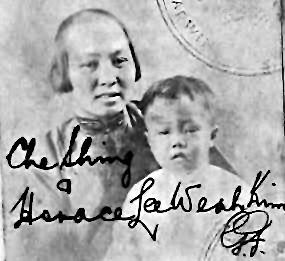
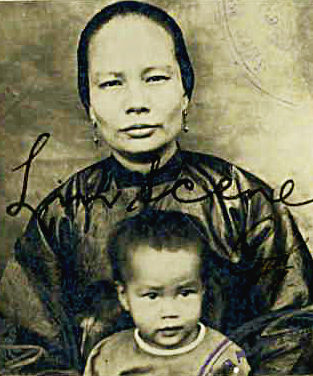 The reason? The possibility existed that these women were not pregnant and might try to smuggle, on return, in a child born in China that was not their own. This intrusion into the lives of these women was justified in this 1928 extract from the files;
The reason? The possibility existed that these women were not pregnant and might try to smuggle, on return, in a child born in China that was not their own. This intrusion into the lives of these women was justified in this 1928 extract from the files;
“If the respective husbands of these women are still at Darwin they should be cautioned against introducing, without special authority from the Department, any child born abroad, and the necessary authority for admission has not been granted, the child should only be permitted to land under the provisions of Section 6, pending reference to this Department.” That is, ........
This directive was sent to all Customs offices in the Commonwealth.
DEPT HOME and TERRITORIES,
CANBERRA. A.C.T.,
19th June,1930
The Collector of Customs,
MELBOURNE VIC .
CHINESE APPLICANTS FOR C.E.D.T.
With regard to the rule under the Chinese Student Regulations that children from l0 to 14 years of age will be admttted for educational purposes only in cases where they are coming to join a parent or parents already residing in Australia it may be stated for your oonfidential information that the Department has reason in a case now under consideration to doubt the bona tides or a Chinese who claims to be the father of two children whose admission is sought.
2. In several other cases, also, the records of visits to China have shown that alleged fathers could not have had children of the ages stated in the applications.
3. As a safeguard in the future, it is desired that all applicants for C.E.D.T should be asked to state whether they are married or not, and if so, the place of residence (if she is living). The form of application (Form No.22) should be amended before issue, to include the following questions which could be written or typed on, viz:
5a. (a) Are you married or single (b) if married, where does the wife reside (if living)?4. If the applicant states that he is married and that his wife resides in China, he should be further questioned, when he calls to have his certificate completed, as to whether he has any children; if so, particulars as to their respective names; date of birth, and sex should be included in a written statement which should be signed by the applicant and the officer who receives it, and attached to the file for future reference if necessary.
F.J.Quinlan
Assistant Secretary
Here's an example from the Victorian files:
NAA: A1, 1912/23832Administration of Immigration Restriction Act
6. P.11, sec.4B para.5
Chinese parents frequently leave their children (especially those under 12) IN CHINA FOR EDUCATIONAL PURPOSES, IN WHICH CASES ENDORSEMENTS ON THE PARENTS' CERTIFICATES WOULD BE OF NO USE. IT ALWAYS SAVES THE DEPARTMENT TROUBLE IF SEPARATE CERTIFICATES ARE OBTAINED for the children in such cases, as an inducement to the parents, I think it would be useful to insert the following clause in this paragraph,viz:- "It may also be pointed out to the parents that, if they obtain "cert...s for their A b children, such "certs will be extended, on application, without "payment of additional fees".
DRAFT The bureaucratic machinery of White Australia: Victoria
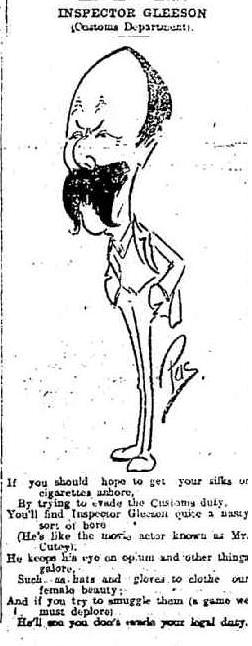
When James Campbell Matthew Gleeson of the Geelong constabulary was promoted to head Federal Customs Police, Victoria branch, in 1916, surveillance of aliens reached new highs. Here was a walloper who lived and breathed street...from dirty pictures to contraband gold to watered-down whiskey to opium smuggling. He fingered his man with Jauvert-like tenacity:
His mission was to end the Victorian opium trade and the Immigration Restriction Act seemed the perfect instrument to achieve this. Criminal conviction for offences required proof beyond reasonable doubt but here innuendo and suspicion could taint a suspect's reputation sufficiently to prevent him re-entering the country. Or so Gleeson thought :
CHIN GOOEY's application for a CEDT and his connection with opium and gambling dens
The Collector,
In reference to the attached application of Chin Gooey I have to report that the applicant is a member of the firm of Sun Nam Hie & Co., Chinese storekeepers, 220 Little Bourke Street.
2. The above-named firm deals in all sorts of Chinese goods and the business is respectably conducted.
3. Although no gambling or opium smoking is carried on on the premises, Chin Gooey is a frequent visitor to Chinese opium dens in the locality. I have driven him out or these places on at least two occasions when I have raided the dens. I have seen him entering the the houses on other occasions.
I don't think he smokes opium but I in informed that he finances at least two opium dens whose interests he looks after.
4. In addition to the opium business I am informed that he has a big interest in at least three (3) gambling dens close to where he lives. At times he assists in the management of these places and may be seen entering and leaving at different hours of the day and night.
5, In view of the questionable business carried on by Chin Gooey, I think it would be advisable for the Collector to forward his application to the Home & Territories Department for information and consideration.
signed J. Glesson
SHE GIN's. Application for an Exemption Certificate
The Collector.
I have to report in connection with She Jins' attached application for an exemption Certificate under the Immigration Act, that I examined him yesterday through Mr. Lum, the Interpreter, and attach his statement. According to it he only arrived here in 1902 which I am confidentially informed is about correct. He also asserted that for the past two years he had been in the employ of Sun Goon Shing, Little Bourke Street, as shopman. On this particular point I can flatly contradict him, as I used to very frequently visit his store during the period mentioned , and knew the principals and employees there, and I can safely say that I have only seen She Jin there once, and that was about two months ago, on which occasion he preceded me into the shop. On the other hand I used to see him moving about in Little Bourke Street almost every time that I went there. He is a very noticeable Chinese and dressed particularly well. Hence he stands out from the others.
2., Fully two years ago it was reported to me that She Jin was one or the leading opium dealers in Melbourne, and subsequent inquiries went to show that this was correct. Two members of the firm of Sun Goon Shing, namely Shee Chin and Louey Hoong were also reported to be big opium dealers. Their practice was to rent a room from some trusted friend in the suburbs, store the opium there and bring it into the City very late at night. I located one of their depots at Toorak about nine months ago, and although I found a number of empty opium tins concealed beneath the floor of the room, I failed to find any opium. I subsequently discovered depots at Moonee Ponds and North Fitzroy, but on each occasion missed the opium. I was informed about 18 months ago that She Gin was constantly travelling out to St. Kilda head by tram for the purposes, so it was alleged, of bringing opium to the city late at night. My informant, whom She Jin knew, attempted to follow him on several occasions, but after going a little distance on the tram would jump off, board another tram going in the opposite direction and return to his starting point, then enter an hotel and slip out the back way, thereby baffling my informant.
3. Another informant of mine shadowed She Jin on foot to Fitzroy one night with a view to discovering where he kept his opium, but the latter suspected that he was being followed, slipped into an hotel in Gertrude Street, Fitzroy and disappeared through the back.
4. It was also reported to me by an informant who was watching him that he used to visit the opium smoking dens daily for orders.
Sometimes he would bring the opium himself, and at other times it was delivered by one or two men whom he employed for the purpose.
5.Some months ago, by permission of the Collector, I engaged a man for a short period to see it he could trap She Jin, but he was unsuccessful, owing to She Jin's astuteness.
6. This man was an associate of Hey Gin and Hey Poo, now serving sentences in Pentridge for conspiracy. After their downfall, he, She Jin, Shee Ghin and Louey Hoong had a monopoly of the opium business here. It has frequently been told to me that She Jin made a small fortune out of opium. He went to Sydney a couple of months ago, and I was appraised of the fact at the time. It was alleged by my informant that he intended to apply for an Exemption Certificate there. I advised the Sydney authorities, but he did not apply.
signed
J. Gleeson
The bureaucratic machinery of White Australia: Part 3: Western Australia DRAFT
The re-entry of Chinese and other coloured migrants into W.A. was controlled by the Immigration Restriction Act of Western Australia 1897. New arrivals had to sit an impossible-to-pass dictation test. In December, 1901, the new Commonwealth passed the Immigration Restriction Act. In Western Australia the transition was largely smooth. Unlike the Queensland practice, re-entry was virtually automatic.
BETWEEN TWO ACTS: 1900-1902 features W.A. studio portraits of predominantly Cantonese working class and lower middle class Chinese with a few Japanese, Afghans and Indians. They were submitted as part of the identification process prior to leaving.
Eurasians under White Australia:
Ernest Sung Yee Horace Sung Yee Herbert Ah Loy

Australian-born Herbert Ah Loy (or Young Gim Gnock) appeared to Customs to be a full blood. Arriving back in Melbourne in February, 1911 after a 26 year absence, he tendered a Victorian birth certificate as proof of entry, perfectly legal as a re-entry document. Unfortunately it did not bear his childhood photo, usually fixed to the document. Customs assumed he was tendering another's birth certificate, and refused him entry as an illegal, a prohibited immigrant. He was allowed to stay on here on a bond to appeal this decision.
The prosecution called expert witness anthropology professor, Dr. R J A Berry and his report is furnished here in full to illustrate the science of physical anthropology as it was in the early 20th Century:
REPORT ON REPUTED HALF CASTE CHINESE.
DATE AND PLACE OF EXAMINATION. The Physical Anthropological laboratory of the University of Melbourne. Friday the 7th July 1911 from 11-0am to 1-30pm.
PERSONS WHO CONDUCTED THE EXAMINATION. Professor R J A Berry, assisted by Dr A W D Robertson (Victorian Government Research Scholar in Anthropology). Dr Colin Mackenzie was not present.
MODE OF CONDUCTING THE EXAMINATION. Photographs taken of the head full face and side face with centimetre scale. All measurements of the entire body recorded in accordance with the instructions of the British Association Anthropometric Investigation Committee 1909.
Skins eyes, hair tested by Lovibond's tintometer.
STATEMENT OF EXAMINEE AS INTERPRETED BY INTERPRETER. Thirty six years of age, born in or off Little Bourke Street, Melbourne of a white woman and a Chinese man. Both parents said to be deceased. Said to have been vaccinated when a child.
SKIN COLOUR. The skin colour of pure bred Chinese varies from a light lemon and almost white shade in the North of China to deep brownish hues in the Southern provinces; or as another Authority expresses it, a yellowish white or sickly hue, the colour of wheat, in the North, to brunette with a strong yellowish tinge in the South, but darker in the South than the North. The skin colour of this individual as tested with the allowing the whole iris to be seen. This Mongolian peculiarity in the eye distinguishes the races of Eastern Asia from ail other races of Mankind. The eye of this individual conforms in every detail to that of the Chinese type as just laid down. Its tintometer colour is darker than the deepest shade at our disposal, that is, it is black.
NOSE. The typical Chinese nose is short, flat, but wide at the end. Normally small and concave but of toll large and straight especially amongst the upper Chinese classes.
The nose of this individual conforms in every detail to the first mentioned type.
STATURE. The stature of the Chinese is generally under the average but presents surprising discrepancies as proved by the popular exhibition of "Chinese Dwarfs" and Chinese “Giants". Measurements recorded on 15682 Chinese from the South gave an average stature of 1622mm. 54:measurements on Northern Chinese gave an average of 1674mm. The stature of this individual 1738mm, that is above the average both from North and south but well, within the normal range of Chinese variation for stature.
HAIR. The hair of the pure bred Chinese is straight, smooth, lank, black, coarse and glossy. This individual conform in every detail to the type. His hair as tested by the Tintometer is black.
BEARD. The beard of pure bred Chinese is always black and very scanty as in this individual. WHISKERS. The whiskers of purebred Chinese are even more scanty than the beard or even altogether absent. As in this individual.
BODILY HAIR. Very little hair grows on the body of the typical Chinese. This individual is no exception to the rule.
FACE. The typical Chinese face is moderately broad and its outline remarkably round as in this individual. 'CHEEKBONES. The cheekbones of pure bred Chinese are high and prominent as in this individual.
THE SKULL. In a series of measurements recorded on. the Skulls (c). al living Chinese from Southern China the skull was found braOhYoephalic••or reund. withh-an 'index of 81,12. 111*t4is his head length Is 204mm* his head breadth 167mt and the Ind-ex •e48 that is braohyoephalio, linder-thts count th4reft. 1).0:o•nl.otms to the...typical Chinese type of
THE TEMPLES. The minimum frontal diameter of the Chinese 41ea narrow, that is, the head is contracted at the temples. On 28 Chinese dried skulls this measurement averaged 92 .6,. On this individual the measurement as recorded on the living subject with the, soft parts in situ was 104 Allowing for the difference of soft parts the individual is thus within the Chinese range This is still more strikingly broulit out by the comparison of the minimum frontal d ameter wilh the maximum head breadth. The proportion more strikingly brought out by the comparison of the minimum frontal diameter with the maximum head breadth. The proportion between these two measurements on 28 Chinese skulls was indicated by the figure 66.5. where the maximum cranial breadth is regarded as being 100. In this individual the maximum breadth. is 157, the minimum frontal diameter is 104 and the resulting index is 62.2. VACCINATION MARKS. The most careful search with a hand lens failed to find any traces of vaccination marks. There is one very doubtful looking mark about the middle of the left upper arm. This seems to be altogether too superficial to be the result of a previous vaccination There are also
similar slight superficial marks on other parts of the body. The general impression of the examiners was that there were no authentic vaccination marks on the individual.
GENERAL REMARKS. A recent writer Herman Scheffauer writing in a popular article on mixed Chinese and Anglo-saxon children says "The other children of this composite household show a peculiar blending of Saxon and Mongolian features, such as almond eyes and retroussé noses." And again on principles of Mendelian heredity the offspring of a cross between a Mongolian father and an Anglo-saxon mother should display some Anglo-saxon characteristics. This individual, on the other hand, does not display one single feature which is not in all essentials absolutely typically Chinese. As prevously stated every measurement has been recorded and can be furnished if necessary. These only vary from the type inasmuch as the Man is rather bigger than the average
Chinese and consequently the various measurements are rather larger than usual. Apart from this there is not one Anglo-saxon feature about the man.
CONCLUSION. We can therefore only conclude that not only is the man not a hybrid between a Chinese and a white mother but that he is not even a cross of any description. He conforms in almost every respect to the Southern Chinese type. In view of the possibility of this case going to a Court of Law we have thought it advisable to have the opinion of two observers who hereby sign themselves as under and are prepared to testify to the truth of this report.
The defence had these three witnesses--
Ah Yen: (cabinet-maker) remembers Herbert Ah Loy since he was 3 or 4 years old. Knew his father when he resided in Victoria. Says Herbert was taken to China about the end of 1884 per "Wangpoa" by one of his cousins named Ah Yook or Ah Fook. Went to see them off. Next saw Herbert when on a visit to China in 1887. Saw him there almost daily during 2 years. Again saw him on another trip to China in 1894. Recognises the man now admitted to Melbourne as Herbert Ah Loy.
Ah Yow (storeman) remembers that Herbert was born in a lane off little Bourke Street, Melbourne, next door to where he (the declarant) lived. Saw him off to China in 1884. Again saw him when on a visit to China in 1889 after 7 years. Met him there at least once a month. Recognises person now admitted as being Herbert Ah Loy.
Ah Kitt (cabinet-maker) states that he is a brother of Ah Fook or Ah Yook. Is a cousin of Herbert Ah Loy. Saw him off to China in 1884. His (the declarants) brother took the lad to China per the "Wangpoa". Says that Herbert is the son of Ah Loy who was living in Victoria with his wife in 1884.
Fortunately for this half-caste, commonsense prevailed in the magistrate's judgement: the Chinese witness's testimony was believed. Herbert Ah Loy was allowed to stay.
Japanese-Queensland agreement
C1926.4554HidetaroKosakaWakayama5.11.1874Laundryman438MilitaryRdMosman24.4.1902
When Hidetaro Kosaka who ran a laundry on Mitary Rd Mossman applied for a CEDT to visit Wakayama in 1918, Customs were astonished to find that he entered in April, 1902 after the Immigration Restriction Act applied. He was one of 106 Japanese who arrived in Townsville on the Kumano Maru.
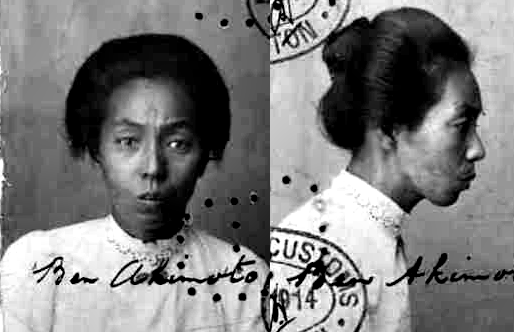
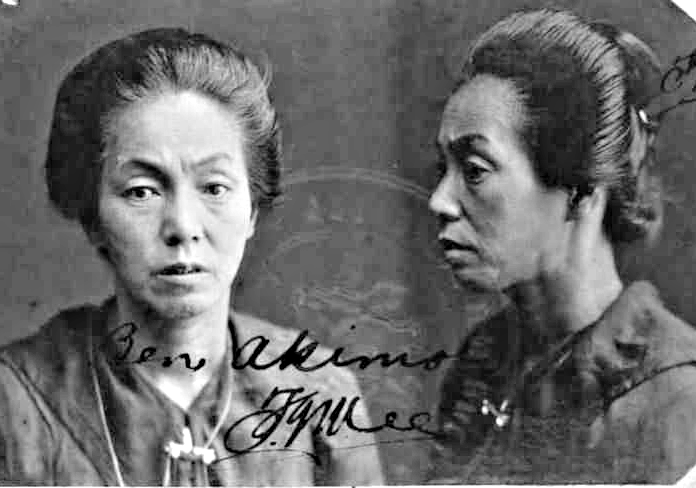
Ben Akimoto, 34, in Longreach in 1914 and 10 years later in Brisbane
Laundress or Sex Worker?
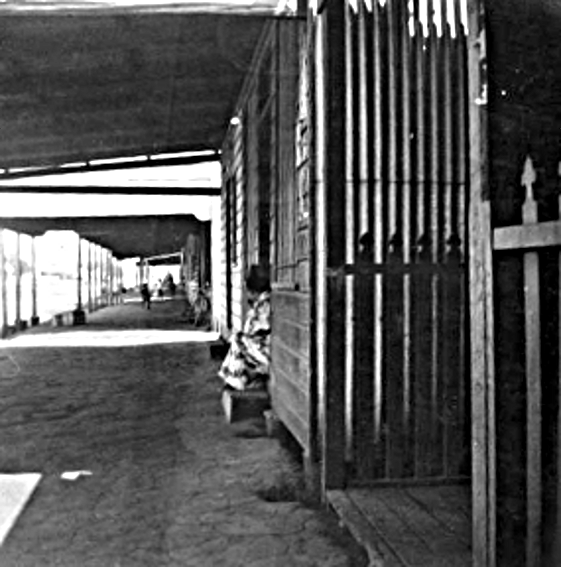
Japanese girl dressed in a kimono in 'Yokohama Street' (Sachs St now Grafton St), Cairns, about 1902.
[This] "street in Cairns, just a mile long, was entirely composed of 'houses of ill fame', the nightly resort of foreigners", wrote an over-enthusiastic travelling journalist at the time.
It was asserted that "the presence of these Japanese women,...was desirable as a means of protecting the wives and daughters of the white citizenry from assault, rape and possible murder by South Sea Islanders and other aliens as had occurred in other sugar growing districts."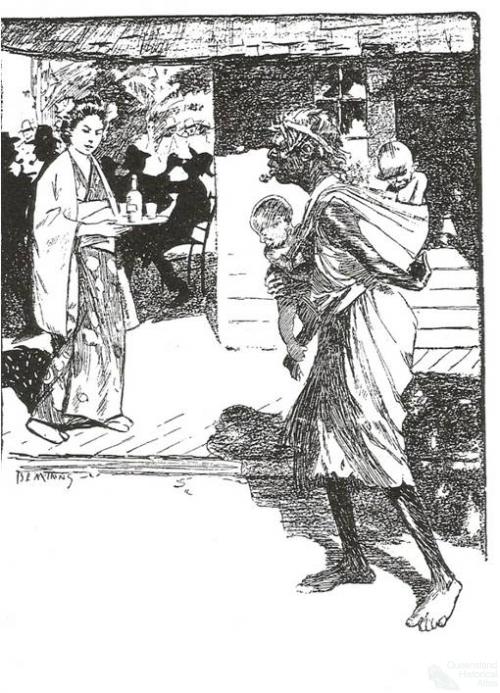
Although the Queensland government knew there were Japanese prostitutes throughout the northern regions of the colony and did have concerns about their activities, it did not restrict their entry. Perhaps it was too hard to determine just how many were actually engaged in prostitution as their houses were ‘not kept as brothels, but as a store, a boarding house, or a laundry’. The government saw Japanese prostitutes as providers of ‘a service essential to the economic growth of the north’ and their sexual services ‘made life more palatable for European and Asian men who worked in pearling, mining and pastoral industries’.
The Bulletin Vol. 25 No.1247 of 7 January 1904 p.16 captioned by an editor: "Asiatic Australia - a phase that is passing away. Federal Parliament is now absolutely dominated by the White Australia party"
Drawn by Black and White artist Benjamin Edwin Minns (b.1863 Dungog d.1937) who specialised in Aboriginal caricatures. In his Sydney studio he imagined this tropical sly grog shanty, with drinkers served by an exotic Karayuki-san whilst an Aboriginal mother with half-caste babies passes by.
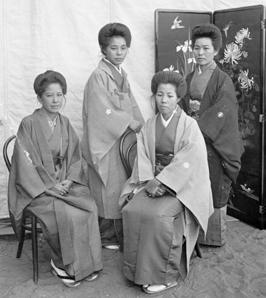

"Japanese women of Broome, 1920". Battye Library, W.A. State library
King Chow was photo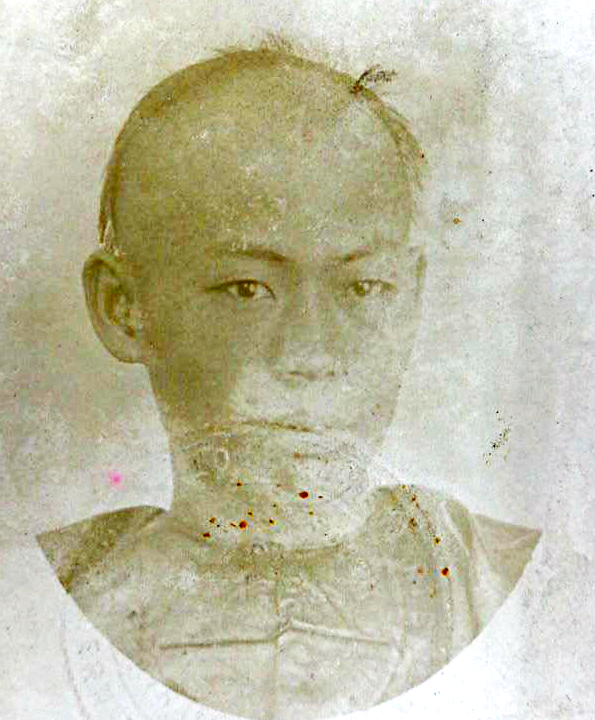 graphed in Palmerston for this S.A. permit dated 5th October 1891 making it the oldest travel permit photo in the National Archives. He later moved to Melbourne where he applied for a CEDT in 1923 and his old permit was placed on his file there
graphed in Palmerston for this S.A. permit dated 5th October 1891 making it the oldest travel permit photo in the National Archives. He later moved to Melbourne where he applied for a CEDT in 1923 and his old permit was placed on his file there
.
Second oldest National archive permit photo in existence. Taken in 1891, three years after the passing of the South Australian Chinese Immigration Restriction Act, 16 year old Darwin waiter, Lee Gin, was identified as Australian born in this permit. He would be allowed to return to the Northern Territory of the South Australian Colony after visiting Canton.. Found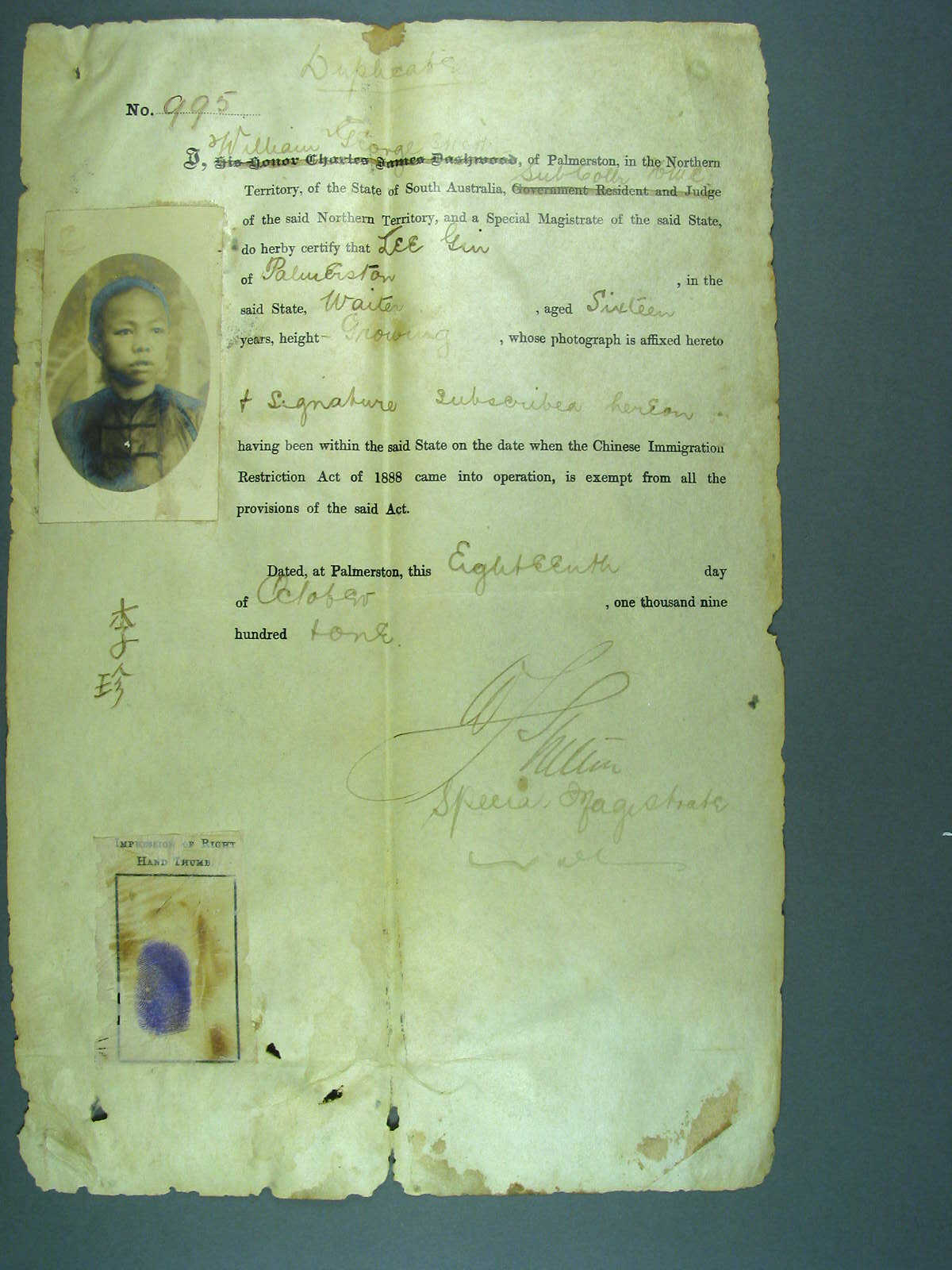
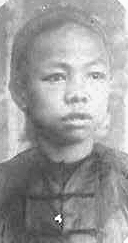
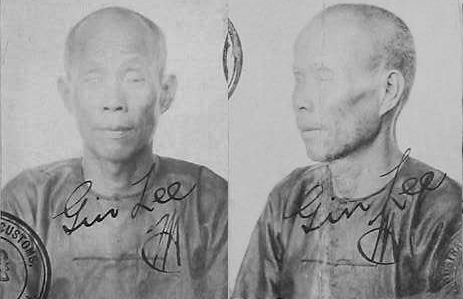 in the Darwin National Archives.(series E752 control symbol 1916/17) He later worked as a fisherman. At 47 years old in 1916, he returned to live in Canton after visiting there for a year between 1909 and 1910.
in the Darwin National Archives.(series E752 control symbol 1916/17) He later worked as a fisherman. At 47 years old in 1916, he returned to live in Canton after visiting there for a year between 1909 and 1910.
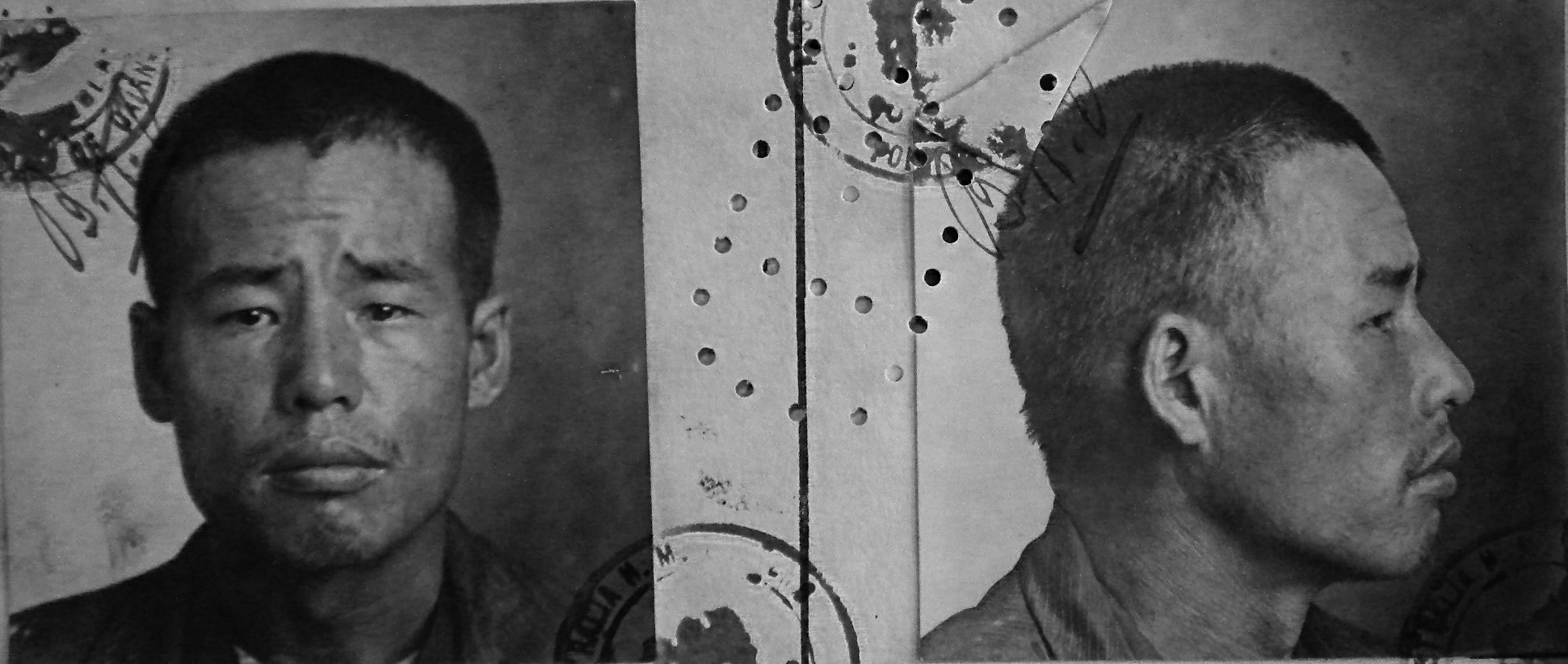
Go Tak was a rural worker on the Atherton tablelands. He was renowned for his knowledge of Chinese medicine and herbs, effecting cures where tradition Western medicine had failed. He cultivated varieties of roses which are still being grown around Ravenshoe (on the Atherton Tablelands, north Queensland) today. The locals named a road after him to honour his contribution to their community. His story is told by Evelyn Fatur in her booklet on his life, available from
Evelyn FaturPO Box 110
Ravenshoe QLD 4872

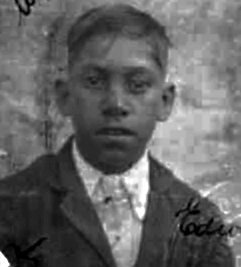
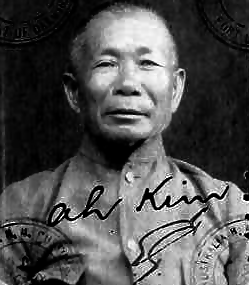

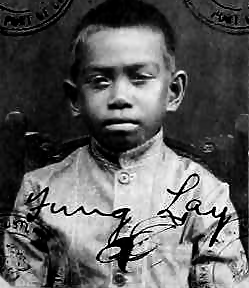
DRAFT: see Fb gp Chinese Aboriginals for update on this article (as at 6.3.2022)
It is commonly thought that Aboriginal children did not receive the benefit of a comprehensive education in the early days of the Commonwealth. Not so for those with middle class Chinese fathers. Although their parents were generally prohibited by the miscegenistic state Aboriginal Protection Acts from officially marrying, their sons were sent to stay with relatives in Canton to be educated in the old ways. This was also the practice with Australian Chinese boys of middle class Chinese parents.
J2483 3/41 WingSouiBorooloolaNT6BoyCamoowealTownsvilleEMPIRE18.2.09
J2483 3415/29 EdwardKeeLowCooktown11y
E752 1908/9 AhTakORGeeTak21.9.05DalyRiverNTStudentDarwin5y
E752 21/18 FungLayMuggsLagoonWyndhamWA17.8.12MuggsLagoonSchoolBoyDarwin8yDarwinVICTORIA14.4.21
DRAFT:Sand tailers, pear cutters, giants and pinhead freaks
"Pear cutters" and the Bounty:
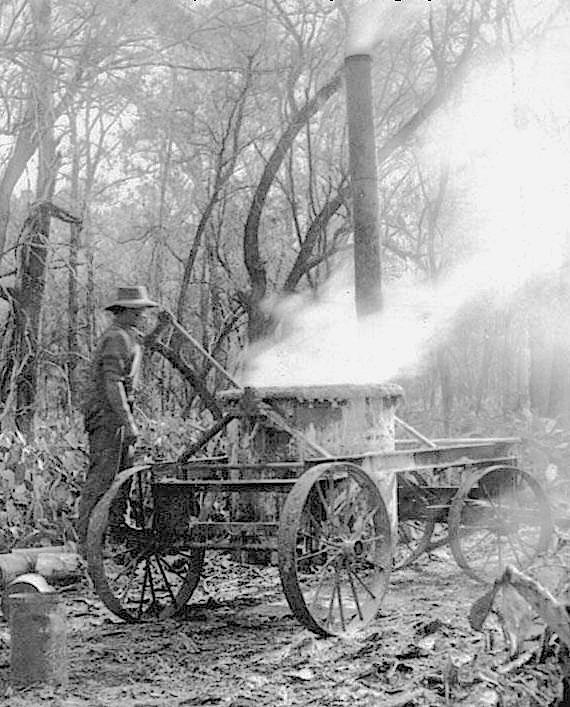
One of the early and drastic prickly pear treatment method - fumes from a boiling arsenic mixture drifting through the scrub (c.1919) northwestweeds.nsw.gov.au
Strychnine was the effective poison used to cull the nation-wide spread of prickly pear but it also killed the rural workers including Chinese labour gangs...
The West Australian (Perth, WA : 1879 - 1954)
Wednesday 13 September 1911 QUEENSLAND. Brisbane, Sep. 12. The Commissioner of Police received a telegram to-day, stating that the Chinese who were poisoned while working on Armadilla Station, were engaged in cutting prickly pear. In their camp was found a drum used for water supply purposes. This had been used by the former camp to hold prickly pear poison. No foul play was suspected. The contents of the stomachs of those who died were being sent to the Government Analyst for analysis.
Two pear cutters whose CEDT photos show the noxious effects of the wor.
k.Click on the thumbnail faces for details:
Far back in the history of Bendigo an extraordinary method was adopted for dealing with most of the tailings and slimes. The values in these tailings were practically sold to Chinese, who in their turn, after they had treated them, had to prevent any sand or slime from finding its way into the watercourses. On many heaps the same system is carried out to-day. The company extracts what it can, then lifts the whole of the material with a sand pump or the more extravagant air-lift to the Chinamen's sheds stuck on top of the heap. The Chinese use crude automatic appliances, which are cleaned up occasionally, and from them the sand and slime gravitates over the nearly flat surface of the heap; the sands settle, but the slimes running on, are impounded in a large surface clam. The main task of the Chinese is to keep the walls of the dam intact, or to provide for an additional one.
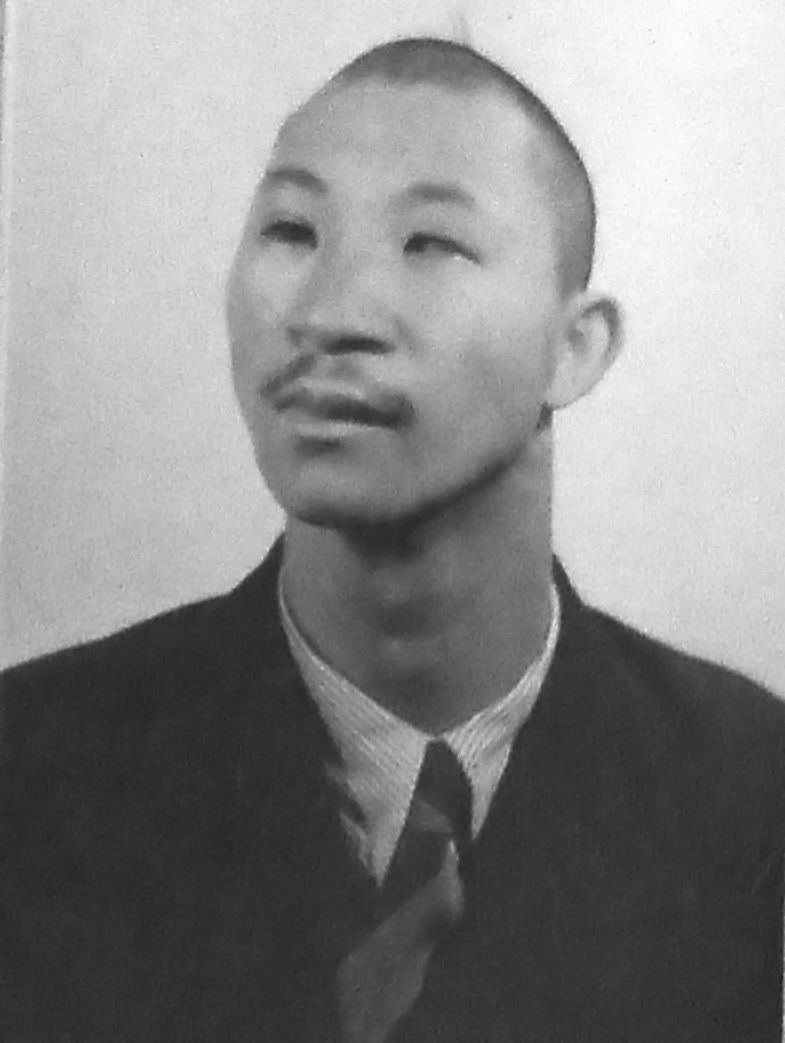
DRAFT:Yan Fan Tai 'Pinhead Freak' employed by Mr. Chong, 201 Lonsdale St Melbourne as an actor, 28, born N.China Stayed for about 8 years 1940 - c.1948

DRAFT other Japanese workers who arrived after IRA first Act who were exempt from the dictatios test see Fb Gp Japanese etc
After working 26 years in coastal Mourilyan, Queensland, 44 year old Yasaki Hayashi decided in 1928 to visit Hiroshima, the city of his birth. He could afford to do this twice more, although he always returned to his job as a sugar cane processor. An 18 year old when he first arrived, he was not aware that his entry was highly controversial.
In fact one newspaper denied it: In the Telegraph of 4 December 1889 NO TRUTH IN THE STATEMENTS THAT 200 JAPANESE LANDED AT MOURILYAN.
A paragraph appeared in the Mackay
if treaty some days ago, stating that 200 Japanese had been landed at
Mourilyan for work on the Mourilyan Sugar Company's plantation. This
statement, without any attempt being made to test its accuracy, has been
telegraphed all over Australia, cartoons have been drawn on the
subject, and the unfortunate Japanese have formed) the them for articles
of the most violent character. Unfortunately for the articles and the
writers, it now turns out that there is no truth whatever In the
statement, and official information has been received in Brisbane that
no Japanese have been landed in the Mourilyan or Johnston River
districts for any of the plantations.
The Mourilyan Sugar Company furnishes a free passage, with proper food, on a first-class steamer, for the labourer and his wife and children if they accompany him. The immigrants will be employed as agricultural labourers only, in and about the plantation. They engage for three years,at $10 a month; women $8; to be paid at the end of the month. A sum of $20 is paid on signature of the agreement, and an equivalent of £9 is left at theyahoo municipal hall in Yokohama, so that a labourer returning will not be without money when he lands. The improvident habits of the Japanese labourers explain this provision. There advances are to be gradually repaid by deductions from wages. When the labourers have reached the plantation, the Sugar Company will provide them free of cost with lodgings good enough for health and reasonable comfort; with a sufficiency of good wholesome food, including a proper portion of meat and bread; a sufficient quantity of fuel and cooking utensils, and with working clothes. In case of sickness arising from other than a specified contagious disease, the company provides medical attendance and medicines, with the services of a competent interpreter. When the sickness is chronic or the agreement expires the company has to send back the labourer and his family to Japan in a suitable vessel, with food, free of cost, from where he was last employed to Yokohama. If a man proves incompetent, and the company would rather pay his passage back than keep him, the money is to be deposited with the consul, who will send him home. The hours of labour will be ten hours per day for men, and eight hours for women; no work to be done on Sundays; overtime, 5d. for thirty minutes. The agreement may be cancelled by the Sugar Company for refusal to work; for insubordination, for drunkenness or gambling, for continued sickness or disability; and, if the agreement is cancelled, the company yields the advance made to the labourer. The company agrees to give the labourer every protection and assistance consistent with the laws of Queensland, and not to interfere with his full and perfect liberty to communicate with his friends and relatives and with the Japanese authorities, or with his right of appeal to the courts of justice in Queensland. The labourer is to conduct himself in a quiet and orderly manner, obey all lawful commands, and observe and obey the laws in force in Queensland.
Wednesday 4 December 1889 Page 2
Japanese Hoax.
NO TRUTH IN THE STATEMENTS
THAT 200 JAPANESE LANDED AT MOURILYAN.
A paragraph appeared in the Mackay if treaty some days ago, stating that 200 Japanese had been landed at Mourilyan for work on the Mourilyan Sugar Company's plantation. This statement, without any attempt being made to test its accuracy, has been telegraphed all over Australia, cartoons have been drawn on the subject, and the unfortunate Japanese have formed) the them for articles of the most violent character. Unfortunately for the articles and the writers, it now turns out that there is no truth whatever In the statement, and official information has been received in Brisbane that no Japanese have been landed in the Mourilyan or Johnston River districts for any of the plantations.—Telegraph.
-------------------------------------------------------
The Brisbane Courier Thursday 28 February 1889
THE IMPORTATION OF JAPANESE LABOUR. "AGRICULTURAL LABOURERS" SENT TO QUEENSLAND.
The recently published information that a company of Japanese labourers has left Yokohama for Australia, under engagement to work in Queensland for a term of years, will (says the Melbourne Age) revive the public interest in the great question of the Asiatic influx, upon which the people of these colonies have pronounced decidedly so far as it concerns the Chinese. The natives of Japan are not popularly classed with the Chinese, and the Japanese themselves strongly repudiate all affinity with that people, but there are some characteristics common to both races, and this new movement will give the Australians an opportunity of comparison by actual acquaintanceship. There has never yet been any foundation for a comparison of the races as fellow citizens. The official visits of Japanese to these colonies have left very pleasant and favourable impressions. So has it been with the Chinese. But in both cases the visitors have been of high caste, and our practical experience is confined to that which we have gathered from contact with the resident Chinese of a low order, and this has not been satisfactory to the colonies. The Japanese importation now in question will be the first of its kind landed in Australia, for the project conceived in Japan some time ago to buy up a Queensland sugar plantation and work it with Japanese labourers did not come into effect. These labourers will not be presented to the scrutiny of the Australians under anything like the same conditions as the average Chinese working his own way in the community, and here again the materials for comparison will be defective. But it is possible, after all, that sufficient insight into their character may be obtained to establish an opinion for or against further importation, and in the hope of obtaining such desirable information the Australian public will, undoubtedly, watch closely for the next three years the progress of this first Japanese immigration.
The batch consists of 100 men, described as agricultural labourers. They have already left Yokohama for their destination, and are, in fact, expected to arrive at Townsville every day. They were engaged in Yokohama on behalf of the Mourilyan Sugar Company, through an English merchant, Mr. W. J. S. Shand, residing in Yokohma. The engagement has the approval of the Japanese Government, which appears to be very well informed on the state of Australian opinion on the Asiatic question, and has paid particular attention to this transaction. The Japanese Government indicated that it is very jealous of the rights of its subjects, and is determined that they shall have fair and just treatment. The departure of this shipment was duly notified to the Consul-General for Australia, Mr. A. Marks, of Melbourne, with full explanations of the wishes of the Government. In the accompanying instructions the consul is addressed as follows:-"Your special care to protect these labourers is regarded as the more urgent in these days, when the temper of public opinion in Australia is so strongly against the Chinese immigration. Judging from the general tone of popular sentiment which you have reported from time to time, it appears that the demonstrations of the working class in Australia have begun to assume a tendency towards what might also be called a race prejudice, for such expressions as
'Asiatics' or 'Asiatic labour' instead of 'Chinamen' or 'Chinese labour' are noticed being used there in the resolutions made by different unions or associations of the working men. Of course we cannot for a moment entertain the idea that these expressions are intended to apply to Japanese as well as other Asiatic people, as there has never occurred anything in the relations between the Japanese and the Australian public that would foster any mutual ill-feeling; but should these terms ever be used in so sweeping a manner as to apply to our nationals, the matter would give serious consideration and present great obstacles to the future attempt of our people to open up direct intercourse with Australia. You are requested to be particularly vigilant and to put forth every effort in order to avoid the ill-feeling that the Australians have contracted against the intending immigrants. Should the working class in Australia ever manifest a tendency to regard our people the same as Chinamen, I hope you will report the matter at once to this department (the Ministry for Foreign Affairs)."
The reference to a future attempt to open up direct intercourse with Australia may be explained as alluding to the contemplated establishment of a direct line of Government mail steamers.
These being the general views of the Japanese Government on the subject, the conditions of contract are equally careful of the welfare of the Japanese labourer. The Mourilyan Sugar Company furnishes a free passage, with proper food, on a first-class steamer, for the labourer and his wife and children if they accompany him. The immigrants will be employed as agricultural labourers only, in and about the plantation. They engage for three years,at $10 a month; women $8; to be paid at the end of the month. A sum of $20 is paid on signature of the agreement, and an equivalent of £9 is left at theyahoo municipal hall in Yokohama, so that a labourer returning will not be without money when he lands. The improvident habits of the Japanese labourers explain this provision. There advances are to be gradually repaid by deductions from wages. When the labourers have reached the plantation, the Sugar Company will provide them free of cost with lodgings good enough for health and reasonable comfort; with a sufficiency of good wholesome food, including a proper portion of meat and bread; a sufficient quantity of fuel and cooking utensils, and with working clothes. In case of sickness arising from other than a specified contagious disease, the company provides medical attendance and medicines, with the services of a competent interpreter. When the sickness is chronic or the agreement expires the company has to send back the labourer and his family to Japan in a suitable vessel, with food, free of cost, from where he was last employed to Yokohama. If a man proves incompetent, and the company would rather pay his passage back than keep him, the money is to be deposited with the consul, who will send him home. The hours of labour will be ten hours per day for men, and eight hours for women; no work to be done on Sundays; overtime, 5d. for thirty minutes. The agreement may be cancelled by the Sugar Company for refusal to work; for insubordination, for drunkenness or gambling, for continued sickness or disability; and, if the agreement is cancelled, the company yields the advance made to the labourer. The company agrees to give the labourer every protection and assistance consistent with the laws of Queensland, and not to interfere with his full and perfect liberty to communicate with his friends and relatives and with the Japanese authorities, or with his right of appeal to the courts of justice in Queensland. The labourer is to conduct himself in a quiet and orderly manner, obey all lawful commands, and observe and obey the laws in force in Queensland.
From this outline of the agreement it will be seen that although the cash wage will be about only 10s. a week, the company finds the labourer in everything, and the total of remuneration will be such that the Japanese labourer will be really well off. It is claimed for the Japanese that they have not those vices and low animal habits which have aroused the Australians against the Chinese and that they are sober and industrious. Parties of Japanese have been employed at Thursday Island, on the pearl shell fisheries, and have been reported on favourably. Whatever vices they had, they had learned from Europeans. However that may be, the Australians will soon be afforded some personal knowledge of the question, for the immigrants are now due, and will be immediately installed on arrival at their quarters on the Mourilyan estate. The secretary to the consul has gone to Japan to conduct the immigrants, and he will see them safely handed over to their employers.
Investigate the politics of the original Japanese plan to invest in farm land?
(Stress the myth of post-colonialism and draw parallels with current controversy re:overseas {Asian} investors?)
Diagram of newspaper article from Japanese Consul Melbourne?
In the final decades of the century, non-European immigrants made up around 4.65% of Queensland’s non-Indigenous population. As a result, in 1895 Queensland refused to introduce a Chinese Restriction Bill advocated by the southern colonies, and was the only Australian colony to sign the 1894 Treaty of Commerce and Navigation between Britain and Japan. Japan’s first Australian consulate was established in Townsville in 1896, to supervise the thousands of Japanese indentured workers. In the nineteenth century Queensland incorporated Asians and Pacific Islanders into its economy in a way never attempted in other Australian colonies.
DRAFT:
DARWIN CHINESE OLD TIMERS
Darwin Nation Archives travel documents for Chinese uniquely contain records of the jobs and times spent working in the Commonwealth. They mirror the history of the development of the colonial North. Taking pre-1880 entry into the Colony as a cut-off, here are the work histories of mainly elderly Chinese who returned to Canton late in life.
VICTORIA CHINESE OLD TIMERS
Ah Lipp was born in 1840 in Canton and arrived in Sydney when he was 18. After spending 4 years working in NSW, he travelled to Bendigo where he worked in the mines. He later became a market gardener in Malmsbury where he worked for 40 years This photo was taken when he was 75 before he returned home.
Pon Ah Hen Tea Hawker
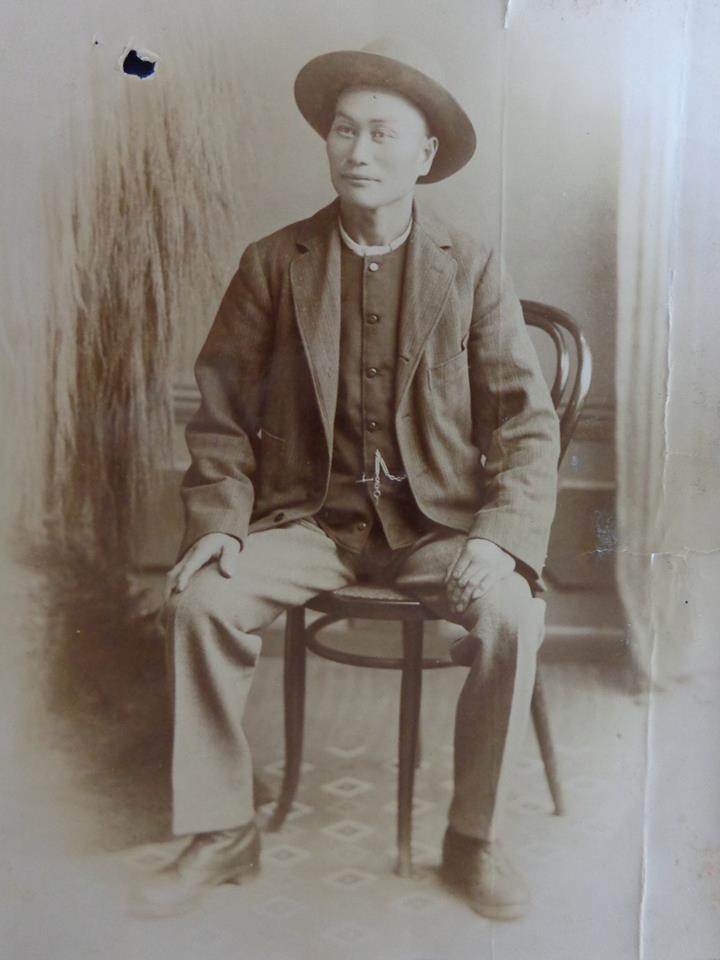
DRAFT: see Fb gp
A3 NT1915/1028 Repatriated to China: Premises in Darwin condemned by the Public Health Board. Group of aged or decrepit Chinese repatriated to China. June 1914










